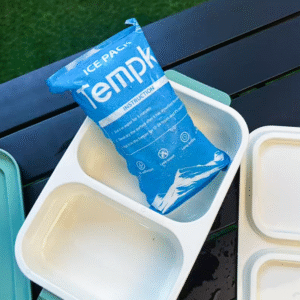Packung mit 100 Trockeneisbeutel: 2025 Cold‑Chain Playbook
Wenn Sie temperaturempfindliche Waren versenden, A Packung mit 100 Trockeneisbeutel standardizes pack‑outs, reduces labor, and extends hold time across hot and cold seasons. This playbook gives you the short rules, validated patterns, and safety tips you need to ship frozen or 2–8 °C with confidence. You’ll see how to size coolant, avoid cold shock, and validate designs without over‑spending or over‑cooling.
-
Why a bulk set improves consistency and cost for multi‑site operations
-
How to right‑size coolant with a quick estimator for 24–72‑hour lanes
-
What to choose: Trockeneisblätter, Gelpackungen, or PCMs for 2–8 °C control
-
So beschriften Sie, Entlüftung, and train teams for compliant, sichere Pack -Outs
Why choose a pack of 100 dry ice pack for routine frozen shipping?
Eine Packung 100 dry ice pack cuts errors and speeds throughput while holding colder set points longer. Pre‑measured units remove guesswork, so new staff can follow SOPs and hit time‑in‑range targets. Bulk buying lowers unit cost and ensures inventory during spikes. Many teams see faster pack‑outs, weniger Umpacken, and steadier temperatures through weekend dwell times.
Think of each unit as a flat, flexible “cold blanket.” Flat packs cover lids, Wände, and corners where heat leaks. That coverage smooths gradients that cause returns or thaw. In der Praxis, you’ll pre‑condition at −20 °C for frozen lanes or near 0–5 °C for chilled. Standardizing counts per carton size accelerates training, improves QA, and makes audits easier. Standardizing on a pack of 100 Trockeneisbeutel also stabilizes reordering and forecasting.
What configuration delivers the best time‑in‑range for your lanes?
Use lid‑and‑floor plus wall strips for 12–24 L boxes; wrap smaller boxes burrito‑style. For tall loads, a 360° band eliminates flap hot spots. Combine a small topper with perimeter coverage to handle last‑mile heat spikes without oversizing the carton. Fangen Sie einfach an, then tune with data loggers. This setup works best when each carton uses a Packung mit 100 Trockeneisbeutel bundle staged by duration.
| Coverage patterns that reduce failures | Fit | Zählen | Was es für Sie bedeutet |
|---|---|---|---|
| Burrito-Wrap | ≤10 L small shipper | 2–4 units | Schnelles Kitten; starker Kantenschutz |
| Deckel + Boden + Wände | 12–24 L shipper | 4–6 Einheiten | Balances vertical gradients |
| 360° Band | Hohe Nutzlasten | 3–5 units | Eliminates flap hot spots |
Praktische Tipps und Ratschläge
-
Hot‑lane seafood: Use full‑coverage lid, add one extra unit for last‑mile dwell.
-
Biologika bei 2–8 °C: Pair wall strips with a +5 °C PCM lid to prevent cold shock.
-
Peak season surge: Pre‑kit tens (10/20/30) so teams grab and go by transit hours.
-
QA photos: Label each image with the lane and the exact count from your Packung mit 100 Trockeneisbeutel.
Real -World -Fall: A coastal dessert brand swapped loose pellets for flat coverage. Time‑in‑range improved by a workday, and pack‑out time fell ~18% with fewer re‑packs.
How many from a pack of 100 dry ice pack do you need per order?
Size a pack of 100 dry ice pack by heat gain, keine Vermutung. A quick baseline is 5–10 lb of dry‑ice‑equivalent per 24 h, adjusted for insulation and ambient. Add 20–30% buffer for delays; subtract if you use VIP shippers. Voraussetzung: −20 °C for frozen, 0–5 °C for chilled. Im Zweifelsfall, start high and tune down—using a Packung mit 100 Trockeneisbeutel lets you do this in clean increments.
Translate hours to day‑equivalents; multiply by a mid‑point dose; then tweak for season and box type. Higher headspace, dünner Schaum, or hot warehouses raise heat gain. Better insulation lowers it. Validate with one hot‑profile test and tune down once you confirm surplus cooling.
Quick estimator you can run in under a minute
-
Transit days = hours/24. 2) Base mass = 7.5 lb × transit days. 3) Buffer = +25%. 4) VIP factor = −15–30%. Beispiel: 48 h Spur, standard EPS → ~14 lb base → +25% ≈ 17.5 lb. Pre‑kit 6–8 flat units per 14 L box and validate with a logger. Document counts per SKU in your SOP as Packung mit 100 Trockeneisbeutel increments for easy auditing.
| Starter counts by shipper size and duration | 24 H | 48 H | Für dich |
|---|---|---|---|
| 8–12 L 2–8 °C | 24 H: 3–4 | 48 H: 5–6 | Small meal kits, Diagnostik |
| 12–18 L 2–8 °C | 24 H: 4–5 | 48 H: 7–8 | Common parcel size |
| Frozen ≤−15 °C | 24 H: +25% | 48 H: +50% | Pre‑condition at −20 °C |
Packung mit 100 dry ice pack vs gel packs vs PCMs — which wins?
Use a pack of 100 dry ice pack for frozen lanes, PCMs for tight 2–8 °C, and gel packs for short chilled routes. Dry ice offers colder set points and longer duration. PCMs lock a narrow range, simplify paperwork, and reduce cold shock. Gel packs are low‑cost for local delivery. For scaling, A Packung mit 100 Trockeneisbeutel keeps dosing repeatable across sites.
Many teams blend strategies: a small dry‑ice topper for heat spikes, PCM at +5 °C on the lid for precision, and flat wall strips for coverage. That cocktail cuts waste while protecting critical SKUs.
Decision aid: refrigerant selection by need
-
Need below −15 °C? Choose dry‑ice‑equivalent coverage.
-
Need +2–8 °C for biologics? Use PCM lids and wall strips.
-
Local chilled groceries? Gel packs suffice if transit <24 H.
-
Mixed catalog? Standardize coverage, vary the lid.
Sicherheit, Beschriftung, and compliance with a pack of 100 Trockeneisbeutel
Treat a pack of 100 dry ice pack like any dry‑ice‑class solution: Entlüftung, Etikett, und trainieren. Packages must vent CO₂; niemals hermetisch verschließen. Markieren Sie „Trockeneis/Kohlendioxid, solide,”UN1845, und Nettomasse. Personal schulen, Tragen Sie isolierte Handschuhe und eine Schutzbrille, and ventilate pack‑out rooms.
Separate product from coolant with a spacer to avoid cold shock or freezer burn. Use CO₂ monitors where you store or handle bulk refrigerant. Publish one‑page job aids so every shift handles acceptance checks the same way. Keep a shadow inventory so every station can pull from a Packung mit 100 Trockeneisbeutel without delay.
2025 Trends: how a pack of 100 dry ice pack fits the future
In 2025, shippers pair a Packung mit 100 Trockeneisbeutel with smarter packaging. VIP + PCM hybrids lower refrigerant mass. Parcel‑profile testing like 7E becomes baseline. Low‑cost data loggers and CO₂ sensors drive faster iteration and fewer claims. Standardisierung um a Packung mit 100 Trockeneisbeutel simplifies playbooks across regions.
Was ist neu auf einen Blick?
-
VIP + PCM-Hybride: Reduce coolant mass while protecting edges and lids.
-
Right‑sizing kits: Match coolant to payload volume to cut dim‑weight and waste.
-
IoT-Überwachung: Alerts teams to heat spikes and CO₂ levels before product risk.
Market insight
Teams report double‑digit reductions in returns after standardizing on coverage patterns, and a measurable drop in labor when pre‑kitting units in tens. Inventory turns improve, zu.
Implementation roadmap for a pack of 100 Trockeneisbeutel
-
Map your top three lanes (Std., Ambient, Isolierung).
-
Choose a coverage pattern and align counts to a Packung mit 100 Trockeneisbeutel.
-
Pre‑kit units in tens by duration (24/48/72 H).
-
Run one hot‑profile test with two variants; keep the winner.
-
Publish a one‑page SOP and retrain quarterly.
Empfohlene interne Links
Quick self‑check and sizing snippet
Häufig gestellte Fragen
How long does a pack of 100 dry ice pack last in transit?
Mit guter Isolierung, expect 24–72 hours. Hot lanes or thin foam shorten duration; VIP lids extend it. Validate with a logger before scaling.
Is a pack of 100 dry ice pack overkill for small teams?
NEIN. Bulk lowers unit cost and speeds training. Flach lagern, Refreeze, and deploy as needed.
Do I need UN1845 labels if I only use PCMs or gel packs?
NEIN. UN1845 applies to dry ice. Still document conditioning and placement, and follow carrier rules.
How do I prevent cold shock for sensitive biologics?
Use a +5 °C PCM lid, minimieren Sie den Kopfspace, and pre‑cool the payload before pack‑out.
Zusammenfassung und Empfehlungen
A Packung mit 100 Trockeneisbeutel improves consistency, beschleunigt das Auspacken, and protects product on hot and long routes. Start with simple coverage, size by heat gain, and validate once—then scale with confidence.
Run a one‑lane pilot this week: choose a pattern, kit tens, Blockentemperaturen, and publish the SOP. Need help tailoring counts and patterns to your boxes? Contact our team for a quick sizing session.
Über Tempk
Tempk designs passive cold‑chain kits for food, Pharma, and advanced materials. We validate against parcel profiles, right‑size coolant, and publish SOPs teams actually use. Clients see longer time‑in‑range and lower dim‑weight with fewer re‑packs.
Ready to standardize your pack‑outs? Request a lane‑specific plan now.
























